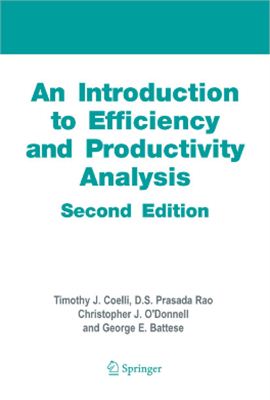Publisher: Springer – 2006, 350 pages
ISBN: 0387242651
An Introduction to Efficiency and Productivity Analysis is designed to be a general introduction for those who wish to study efficiency and productivity analysis. The book provides an accessible, well-written introduction to the four principal methods involved: econometric estimation of average response models; index numbers, data envelopment analysis (DEA); and stochastic frontier analysis (SFA).
For each method, a detailed introduction to the basic concepts is presented,; numerical examples are provided, and some of the more important extensions to the basic methods are discussed. Of special interest is the systematic use of detailed empirical applications using real-world data throughout the book.
Contents:
List of Figures
List of Tables
Preface
Introduction
Some Informal Definitions
Overview of Methods
Outline of Chapters
What is Your Economics Background?
Review of Production Economics
Introduction
Production Functions
Transformation Functions
Cost Functions
Revenue Functions
Profit Functions
Conclusions
Productivity and Efficiency Measurement Concepts
Introduction
Set Theoretic Representation of a Production Technology
Output and Input Distance Functions
Efficiency Measurement using Distance, Cost and Revenue Functions
Measuring Productivity and Productivity Change
Conclusions
Index Numbers and Productivity Measurement
Introduction
Conceptual Framework and Notation
Formulae for Price Index Numbers
Quantity Index Numbers
Properties of Index NumbersThe Test Approach
The Economic-Theoretic Approach
A Simple Numerical Example
Tansitivity in Multilateral Comparisons
TFP Change Measurement Using Index Numbers
Empirical ApplicationAustralian National Railways
Conclusions
Data and Measurement Issues
Introduction
Outputs
Inputs
Prices
Comparisons over time
Output aggregates for sectoral and economy-wide comparisons
Cross-country comparisons of productivity
Data editing and errors
Conclusions
Data Envelopment Analysis
Introduction
The Constant Retus to Scale DEA Model
The Variable Retus to Scale Model and Scale Efficiencies
Input and Output Orientations
Conclusions
Additional Topics on Data Envelopment Analysts
Introduction
Price Information and Allocative Efficiency
Non-Discretionary Variables
Adjusting for the Environment
Input Congestion
Treatment of Slacks
Additional Methods
Empirical ApplicationAustralian Universities
Conclusions
Econometric Estimation of Production Technologies
Introduction
Production, Cost and Profit Functions
Single Equation Estimation
Imposing Equality Constraints
Hypothesis Testing
Systems Estimation
Inequality Constraints
The Bayesian Approach
Simulation Methods
Conclusion
Stochastic Frontier Analysis
Introduction
The Stochastic Production Frontier
Estimating the Parameters
Predicting Technical Efficiency
Hypothesis Testing
Conclusions
Additional Topics on Stochastic Frontier Analysis
Introduction
Distance Functions
Cost Frontiers
Decomposing Cost Efficiency
Scale Efficiency
Panel Data Models
Accounting for the Production Environment
The Bayesian Approach
Conclusions
The Calculation and Decomposition of Productivity Change Using Frontier Methods
Introduction
The Malmquist TFP Index and Panel Data
Calculation using DEA Frontiers
Calculation using SFA Frontiers
An Empirical Application
Conclusions
Summary of Methods
Relative Merits of the Methods
Some Final Points
Appendix Computer Software
Appendix Philippines Rice Data
References
Author Index
Subject Index
ISBN: 0387242651
An Introduction to Efficiency and Productivity Analysis is designed to be a general introduction for those who wish to study efficiency and productivity analysis. The book provides an accessible, well-written introduction to the four principal methods involved: econometric estimation of average response models; index numbers, data envelopment analysis (DEA); and stochastic frontier analysis (SFA).
For each method, a detailed introduction to the basic concepts is presented,; numerical examples are provided, and some of the more important extensions to the basic methods are discussed. Of special interest is the systematic use of detailed empirical applications using real-world data throughout the book.
Contents:
List of Figures
List of Tables
Preface
Introduction
Some Informal Definitions
Overview of Methods
Outline of Chapters
What is Your Economics Background?
Review of Production Economics
Introduction
Production Functions
Transformation Functions
Cost Functions
Revenue Functions
Profit Functions
Conclusions
Productivity and Efficiency Measurement Concepts
Introduction
Set Theoretic Representation of a Production Technology
Output and Input Distance Functions
Efficiency Measurement using Distance, Cost and Revenue Functions
Measuring Productivity and Productivity Change
Conclusions
Index Numbers and Productivity Measurement
Introduction
Conceptual Framework and Notation
Formulae for Price Index Numbers
Quantity Index Numbers
Properties of Index NumbersThe Test Approach
The Economic-Theoretic Approach
A Simple Numerical Example
Tansitivity in Multilateral Comparisons
TFP Change Measurement Using Index Numbers
Empirical ApplicationAustralian National Railways
Conclusions
Data and Measurement Issues
Introduction
Outputs
Inputs
Prices
Comparisons over time
Output aggregates for sectoral and economy-wide comparisons
Cross-country comparisons of productivity
Data editing and errors
Conclusions
Data Envelopment Analysis
Introduction
The Constant Retus to Scale DEA Model
The Variable Retus to Scale Model and Scale Efficiencies
Input and Output Orientations
Conclusions
Additional Topics on Data Envelopment Analysts
Introduction
Price Information and Allocative Efficiency
Non-Discretionary Variables
Adjusting for the Environment
Input Congestion
Treatment of Slacks
Additional Methods
Empirical ApplicationAustralian Universities
Conclusions
Econometric Estimation of Production Technologies
Introduction
Production, Cost and Profit Functions
Single Equation Estimation
Imposing Equality Constraints
Hypothesis Testing
Systems Estimation
Inequality Constraints
The Bayesian Approach
Simulation Methods
Conclusion
Stochastic Frontier Analysis
Introduction
The Stochastic Production Frontier
Estimating the Parameters
Predicting Technical Efficiency
Hypothesis Testing
Conclusions
Additional Topics on Stochastic Frontier Analysis
Introduction
Distance Functions
Cost Frontiers
Decomposing Cost Efficiency
Scale Efficiency
Panel Data Models
Accounting for the Production Environment
The Bayesian Approach
Conclusions
The Calculation and Decomposition of Productivity Change Using Frontier Methods
Introduction
The Malmquist TFP Index and Panel Data
Calculation using DEA Frontiers
Calculation using SFA Frontiers
An Empirical Application
Conclusions
Summary of Methods
Relative Merits of the Methods
Some Final Points
Appendix Computer Software
Appendix Philippines Rice Data
References
Author Index
Subject Index

